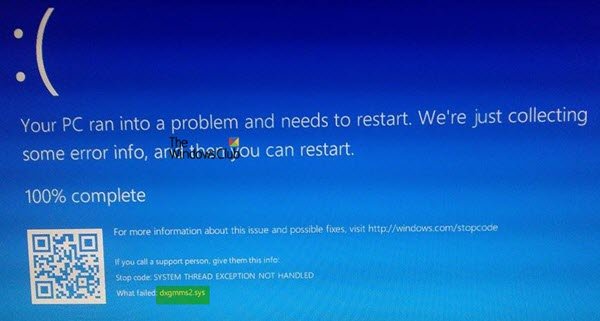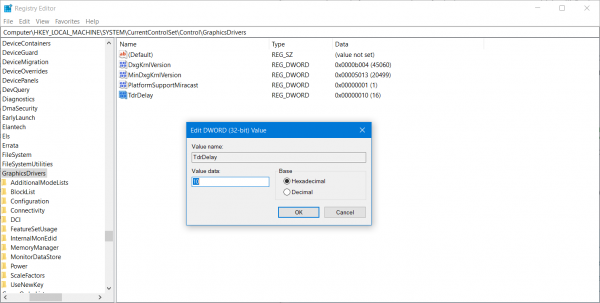The dxgmms2.sys file is a Windows system driver file associated with a computer’s Graphics Rendering capabilities. This file is known to cause a Blue Screen error or BSOD. The main reasons include conflicts like RAM or Hard Disk Issues, incompatible firmware, or corrupt drivers. Fixing this issue is straightforward. However, there are various potential workarounds for it. This applies to Windows 11 and Windows 10.

There can be the following BSOD Errors that are related to this file:
- SYSTEM_THREAD_EXCEPTION_NOT_HANDLED
- SYSTEM_SERVICE_EXCEPTION
- KMODE EXCEPTION NOT HANDLED.
- PAGE FAULT IN A NONPAGED AREA.
- IRQL NOT LESS OR EQUAL.
Fix dxgmms2.sys Blue Screen error
If this error just started to occur and you have a System Restore Point created already, you can use it to revert it to your earlier settings and configuration. If not, you can just create one right after using other fixes and use it in the future if you face any similar error.
We will be undertaking the following fixes to get rid of this error,
- Reinstall Graphics Card Drivers.
- Run DirectX Diagnostic Tool.
- Update or re-install DirectX.
- Reset BIOS Configuration.
- Check Registry settings.
- Disable Sleep Functionality.
1] Issues related to Graphics Card Drivers
Now, the best practice for you should be to go to the website of your manufacturers like NVIDIA, AMD or Intel. Go to the section called Drivers. And download the latest definitions from there. After the download has been completed, just install the graphics driver and reboot your computer.
Find the latest Graphics Drivers for NVIDIA from here, AMD from here and Intel from here.
There is another way. You may use Display Driver Uninstaller to remove AMD, INTEL, NVIDIA Drivers, and then use NVIDIA Smart Scan, AMD Driver Autodetect or Intel Driver Update Utility to download and install or update the respective drivers.
2] Run DirectX Diagnostic Tool
As mentioned above, this error is related to DirectX Graphics APIs. So, in order to fix the issue, you can try to run the DirectX Diagnostic Tool.
3] Update or re-install DirectX
Another basic fix for the issue is to update or reinstall DirectX. By updating or reinstalling DirectX, you can just replace the corrupt or incompatible components of DirectX from your computer.
4] Reset the BIOS Configuration
You can also try to Reset the BIOS Configuration and check if that fixes your issues.
5] Using the Registry Editor
Type regedit in the Search box and hit Enter. Once Registry Editor opens, navigate to the following key-
HKEY_LOCAL_MACHINE\SYSTEM\CurrentControlSet\Control\GraphicsDrivers
Now, right-click on the right-side panel and click on New > DWORD (32-bit) Value.
Set the name of this newly created DWORD as TdrDelay.

Double click on the newly created DWORD and set its value as 10. This will set the response time for your GPU to be 10 Seconds, changing it from 2 seconds which is the default.
Exit the Registry Editor and then reboot your computer for the changes to take effect.
6] Disabling the Sleep Functionality
Sometimes the Sleep functionality of the display might also cause this BSOD. Sometimes while the graphics card’s drivers are being used in the background, the display goes to sleep, and then when it is awakened, it may cause this BSOD. To stop this, you can prevent your computer from getting into Sleep mode.
PS: This SYSTEM THREAD EXCEPTION NOT HANDLED Blue Screen can also occur for other drivers like nviddmkm.sys or atikmpag.sys, iaisp64 sys, PCI.sys, Netwtw04.sys, Idiagio.sys, etc.
How do I fix frequent BSOD in Windows?
On broader levels, it could be because of driver issues or Windows Update, or hardware failure. You will start with a small investigation if you recently update the driver or was a Windows Update rolled out. If yes, then uninstall it, and check if this helps.
If these don’t work, then you may need to check with the hardware, but before that make sure to run the hardware troubleshooter.
Is Blue Screen of Death fixable?
While it is not guaranteed, many BSOD codes can be fixed. Check out our detailed guide on how to fix various BSOD screens by following this quick guide. Driver issues, Windows Update, hardware failure, conflicting software are some of the common reasons for BSOD.
Is there a way to disable the Windows Error Recovery Screen?
If you are seeing the Recovery Screen every time you reboot then there is a problem that you need to fix. However, if you still want to disable the screen, then do the following after you login to your account:
- Press Win key + S to open Search
- Type CMD, and once it appears, right-click and Run as administrator.
- Type the following command
bcdedit /set bootstatuspolicy ignoreallfailures.
Reboot and check if the issue still exists.
Let us know if anything here helped you.
Leave a Reply